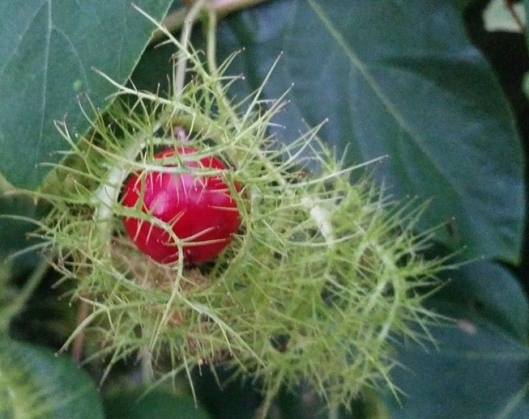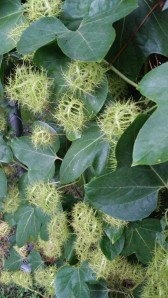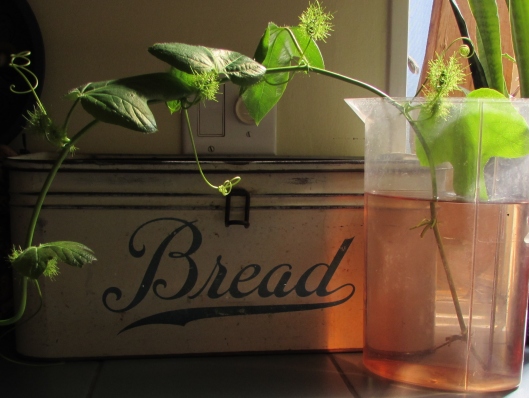Tags
Fetid passionflower, Passiflora foetida Passiflora foetida L. Corona de Cristo, Scarlet-fruit passion flower
I love to walk around my neighborhood to see what thrives and what doesn’t. Last week I came upon the strangest looking prickly looking cages, some around red seed pods. I did think the plant looked like some kind of passion vine but it took some research and with the help of Facebook friends and a local grower I found out it is a Passiflora foetida L., also known as Corona de Cristo, Scarlet-fruit passion flower, Fetid passionflower in the family Passifloraceae (Passion-Flower Family)
I did think the plant looked like some kind of passion vine but it took some research and with the help of Facebook friends and a local grower I found out it is a Passiflora foetida L., also known as Corona de Cristo, Scarlet-fruit passion flower, Fetid passionflower in the family Passifloraceae (Passion-Flower Family)
The first time I saw them there were no flowers blooming or then I would have knows at least that it was a variety of Passion Flower. According to Wikipedia – “There are in excess of 500 species mostly occurring in the Neotropics, but with a few species in the Nearctic and some others in Asia and Australasia.”

 I wonder how long it has been growing there. My neighborhood is over one hundred years old and I often find plants growing here that you don’t see in the local nurseries. I am fortunate to live in a place with such diversity. When you go to the newer neighborhoods you see a lot of similar planting that are popular with the builders. Then you have the HOA’s with their limited planting list trying to achieve a uniform look. Personally I don’t understand the look which is why I could never live in a planned community. Now in the Heights we do have the builder’s landscaping more and more as they tear down little bungalows and put in big homes that go from lot line to lot line. But even those quickly change. We get many calls from people in new construction asking us to give them a unique garden.
I wonder how long it has been growing there. My neighborhood is over one hundred years old and I often find plants growing here that you don’t see in the local nurseries. I am fortunate to live in a place with such diversity. When you go to the newer neighborhoods you see a lot of similar planting that are popular with the builders. Then you have the HOA’s with their limited planting list trying to achieve a uniform look. Personally I don’t understand the look which is why I could never live in a planned community. Now in the Heights we do have the builder’s landscaping more and more as they tear down little bungalows and put in big homes that go from lot line to lot line. But even those quickly change. We get many calls from people in new construction asking us to give them a unique garden.
After finding out the name of this vine and doing some research on it I learned it is easy to propagate from cutting or seeds. I checked the Lady Bird Johnson Wildflower Center to see if they are native. And they are native here in Texas and in several other states. They like to grow in thickets, ditches and meadows with sand and saline low spots in the south of Texas.
They prefer medium water and sun to part shade. The flowers open in the morning and close in the evening and you can have blooms from May through October. Maybe I didn’t see the flowers the first time because it was almost 7pm. They are listed as annuals but this vine looked like it had been there for years. I will have to remember to check back at the end of winter. They grab on and climb with long tendrils. The fruits are edible and can taste mildly sweet to tart. The young leaves and plant tips are also edible. They attract butterflies and are the larva host to the Gulf Fritillary.
Perhaps next year I will have them growing in one of the gardens of Ravenscourt!
Happy Gardening!





What a cool looking passion flower! I love the cages & hope that both cuttings and seeds are successful for you!
LikeLiked by 1 person
I’ll keep you posted Peter. I think it is cool they are native to Texas.
LikeLike
How fortunate to have found one! I was looking for one of these all over and found them only at botanical gardens (other Passifloras vines). This one I’ve not seen. It’s such a beauty.
LikeLike
Maria, I would be happy to send you some fruit, seed pods. The vine is just down the street and there is more fruit. You can send me an email via my company website http://www.ravenscourt.us. There is a contact form and I will get it an email you back via my personal email.
LikeLike
That sounds great, thanks so much.💐
LikeLike
I would love to have a few seeds as well, if that’s still possible. I’ve been searching for years for this particular plant.
Many thanks,
Juanita
LikeLike
Love those cages and the fruit, quite interesting. Funny I also posted bat propagating passion flowe today (on the plant lust blog).
http://plantlust.com/blog/2014/10/making-new-plants-aka-propagating/
LikeLike
What a strange-looking plant. I hate it when they build those McMansions that go from lot line to lot line.
LikeLike
They are so interestingly fun! I worry that people think they need so much room to live in…the little bungalows were so much more energy efficient!
LikeLike
What a great post! I had no idea about this plant – thanks!
LikeLike
Thank you Jan : ) I didn’t either it was fun tracking down what it is and more about it.
LikeLike
It’s a unique-looking plant, for sure. I saw it at the Wildflower Center in fall 2011 and blogged about it because it really caught my eye too: http://www.penick.net/digging/?p=14441. I’m interested to see how it grows in your garden.
LikeLike
It is Pam, thanks for the link to your post!
LikeLike
I’m so happy to have found your article this morning. I found this vine growing in a San Antonio neighborhood and have been researching to no avail until stumbling upon your wonderful little article. I’m going to have to sneak back and see if it is blooming, and snatch a couple of the seed pods. Such an interesting looking plant.
LikeLiked by 1 person